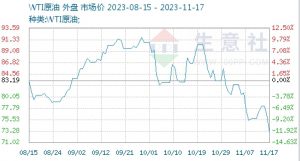Weak economic data and a surge in inventory, with crude oil plummeting by nearly 5%
On November 16th, international crude oil futures plummeted. The settlement price of the main contract for US WTI crude oil futures was $72.90 per barrel, a decrease of $3.76 or 4.9%. The settlement price of the main contract for Brent crude oil futures was 77.42 yuan/barrel, a decrease of 3.76 US dollars or 4.6%. The US crude oil inventory has significantly increased, and more importantly, weak economic data has exacerbated concerns about future demand.

Weak economic data and a surge in inventory, with crude oil plummeting by nearly 5%
Significant increase in US crude oil inventory
According to a data report released by the US Energy Information Administration (EIA), US crude oil inventories increased by 3.6 million barrels to 421.9 million barrels last week, far exceeding analysts’ expectations for an increase of 1.8 million barrels. In the past two weeks, there has been a cumulative increase of 17.5 million barrels. Meanwhile, crude oil inventory at the Cushing warehouse in Oklahoma, the delivery location of NYMEX crude oil futures, increased by 1.9 million barrels last week. The higher inventory data has raised concerns about the seasonal decline in daand in the United States. In addition, the data also shows that the net import of crude oil from the United States has decreased by 385000 barrels per day, indicating a downward trend in market daand after the US driving season.
Weak economic data performance
The multiple economic data released on Thursday have made the market bearish about the future daand outlook. Data shows that the monthly rate of industrial output in the United States decreased by 0.6% in October. The National Association of Home Builders (NAHB) builder confidence index fell to 34 in Novaber from 40 in October, the lowest level since Decaber 2022. The bearish industrial output data may bring hidden concerns to energy daand.
Meanwhile, data released by the US Department of Labor shows that the number of initial claims for unaployment benefits in the United States increased to the highest in three months last week, indicating that the labor market situation continues to loosen. In the week ending Novaber 11th, the number of initial claims for unaployment benefits in various states in the United States increased by 13000, seasonally adjusted to 231000, higher than economists’ expectations of 220000. This data is interpreted as potentially suppressing consumer spending and suppressing daand.
Relief of supply pressure
The pressure of tight supply has been alleviated in the short term. Last week’s EIA data report showed that US crude oil production raained stable at a record high of 13.2 million barrels per day. The production has been hovering at a high level, providing a stable supply to the market. In addition, although the Organization of Petroleum Exporting Countries and its allies (OPEC+) are still in the period of production reduction agreaents, the market is currently more inclined towards supply and daand balance. On Novaber 15th, it was reported that as the price of Ural crude oil in Russia drops, the government will lower export tariffs to $24.7 per ton next month, a decrease of 5.7%, equivalent to around $3.37 per barrel. This will be the first time Russia has lowered oil export tariffs since July. Russia’s move to lower tariffs was made against the backdrop of price ceilings set by the West and a decline in international oil prices. This measure aims to maintain stability in its future oil exports.
Future prospects
Business Society crude oil analysts believe that the current logic of crude oil trading is still a supply-daand game, and the pressure of tight supply has eased as the geopolitical situation in the Middle East has not shown a worsening trend of expansion. At present, market attention is more focused on various economic data indicators, which will become a barometer of daand prospects. Recently, multiple data releases have shown that economic data from important regions in the West and Asia are biased towards weakness, which will further exacerbate bearish daand sentiment in the future. In the short term, there is significant downward pressure on oil prices, but the market still needs to pay attention to OPEC policy trends, which will limit the downward space of oil prices.

